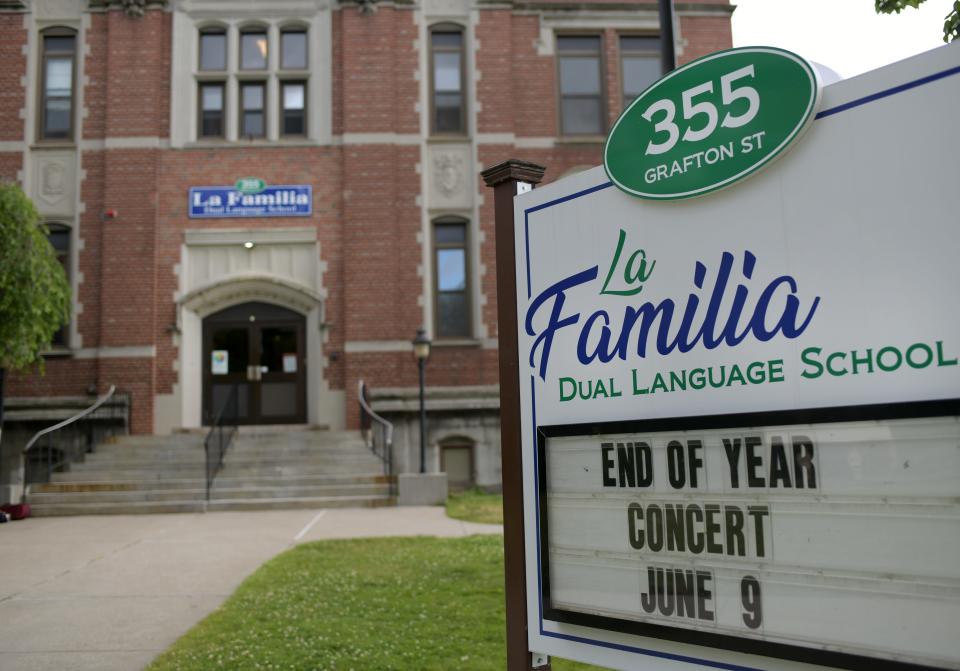Worcester draws up report card on multilingual programs, students
WORCESTER — With 58.4% of the district’s 24,327 students not speaking English as their primary language, district leaders are looking into the current state of multilingual programs and student performance to get an idea of how to best serve those students and expand offerings.

“As a district we are in full motion to ensure we have the best, highest quality education for our multilingual students,” said Carmen J. Melendez-Quintero, director of multilingual education at Thursday evening’s school committee meeting. “The district is taking steps to ensure we have the right conditions and resources for our multilingual students to thrive.”
District administrators gave a snapshot into both the demographics of the district’s student body and how the multilingual student population has performed recently.
Out of the district’s 24,327 students, 45.8% identify as Hispanic, and Spanish is the most spoken language aside from English, with over 7,500 speaking the language, Melendez-Quintero said.
Students who identify as White make up the next majority at 26.9%, African American at 16.7%, Asian at 6%, Multi-Race and Non-Hispanic at 4.1%, and Native American at 0.2%.
In total, 30.4% of students in the district, or 7,395, are English learners, with 1,286 being long-term English Learners, meaning they have had that status in Massachusetts for at least six years. Additionally, 22.5%, or 5,472 students were born outside of the United States.
Melendez-Quintero said that many students in the district also intersect with other demographic areas. Students with disabilities make up 20% of the student body, while 71.3% are from low-income households.
A Hispanic student may not only be an English learner, she said, but also be from a low-income household or have a disability.
While Spanish was the most spoken non-English language in the district, administrators also provided the next 10 most spoken languages in the district in descending order. None had more than 2,500 students:
Portuguese
Twi
Vietnamese
Arabic
Albanian
Swahili
Haitian Creole
French
Nepali
Farsi
Administrators compared student English Proficiency Levels to Massachusetts Comprehensive Assessment System scores, giving members an idea of how the district’s English learners and multilingual learners are performing.
English Proficiency Levels are scaled on a score from one to six and are a representation of what students can do in English, including reading, writing, listening and speaking scores.
Those categories are scored independently, and then put together to give students an overall composite score.
English Proficiency Level One (EPL 1) is a student who is just beginning to use English, while a student who has achieved English Proficiency Level Six is recognized as a “former” English learner, as they are considered to be “proficient” at the language.
1,660 students at EPL 1
Emily Goldstein, the assistant director of multilingual programs, said 1,660 students from pre-kindergarten to sixth grade are EPL 1, while there are 502 in seventh through eighth grades.
There are 930 pre-kindergarten to sixth graders in EPL 2, 1,336 in EPL 3, 892 in EPL 4 and 86 in EPL 5. For seventh through eighth grade, 632 are EPL 2, 949 are EPL 3, 533 are EPL 4, and 20 are EPL 5.
Because students are recategorized upon reaching EPL 6, there were no numbers shared at the meeting.
District administrators were able to show how EPL scores compared to MCAS score achievements, showing that as students rose in their EPL score placements, the better they did on the state standardized exam.
The majority of students in EPL 1, at 89% scored “Not Meeting Expectations” on the MCAS in English language arts, while 11% scored “Partially Meeting Expectations." None scored “Meeting or Exceeding Expectations.”
But by EPL 5, 28% students were “Meeting or Exceeding Expectations,” 70% were “Partially Meeting Expectations” and only 2% were “Not Meeting Expectations.”
Students saw similar results for their math MCAS scores, with 73% of EPL 1 students scoring “Not Meeting Expectations,” 27% scoring “Partially Meeting Expectations,” and none scoring “Meeting or Exceeding Expectations.”
But by EPL 5, only 9% were scoring “Not Meeting Expectations,” while 31% were “Meeting or Exceeding Expectations” and 60% were “Partially Meeting Expectations.”
Options for multilingual learners
Currently the district offers several different options for multilingual learners, including the opportunity to enroll in dual language programs, at schools like Chandler Magnet School and La Familia Dual Language Program on Grafton Street, or in Sheltered English Immersion (SEI), which are courses taught by endorsed teachers to help English learners develop English proficiency.
But by using the data gathered, administrators said they would be able to look how they can improve the programs that already exist, as well as help those programs grow to include more students.
They also put together a road map, made up of five phases, that showed how they plan to approach this improvement and expansion, first beginning with an audit that will look at the district’s practices and program models and put together a report of areas of strengths and areas that need improvement.
From there, a “workgroup” made up of different stakeholders will look at the report and begin looking at the recommendations that will then move into the third phase, which focuses on prioritizing the different recommendations.
Afterwards, an implementation plan will be developed based on the prioritized recommendations before entering the fifth and final phase, which will be the development of a “Road Map for Continuous Improvement.”
“Our multilingual scholars … they’re ready to advance,” said Superintendent Rachel H. Monárrez. “The more we improve upon our district systems, and support our educators at our schools, our children will get those outcomes that we know we can.”
This article originally appeared on Telegram & Gazette: Worcester draws up report card on multilingual programs, students

